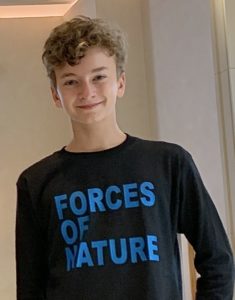By Will Charouhis, Forces of Nature
This month we celebrated the 50th anniversary of Earth Day. But it didn’t feel like much of a celebration.
Fifty years ago, America demonstrated the innovation that built this country. In 1969, NASA sent men to the moon and Boeing flew the 747 inaugural test flight, debuting the world’s first-ever jumbo jet. And in 1970, IBM introduced the floppy disc, allowing information to be shared across computers — foretelling the birth of Microsoft in 1975 and Apple in 1976.
The first Earth Day was a celebration. Some 20 million Americans took part in demonstrations, marches, and environmental cleanups. Americans’ enthusiastic turnout brought a decade of change: President Richard Nixon started the Environmental Protection Agency in 1970, and Congress passed the Clean Air Act in 1970, the Clean Water Act in 1972, and the Endangered Species Act in 1973.

That decade ended with the first United Nations World Climate Conference in 1979. America was off to a strong start, and just in time, because carbon emissions were climbing and the planet was warming.
But as the years passed, we somehow got lost. The next World Climate Conference would not be held until 1990. The third World Climate conference didn’t occur until 2009, and though China had overtaken America as the world’s largest carbon emitter, America still was the largest historical carbon emitter.
America’s presence was sorely missed at this past year’s World Climate Conference in Madrid, Spain. That first conference of 2,000 scientists in 1970 had grown to 26,706 attendees in 2019. It was my first ever, and I arrived to see country pavilions showcasing their impressive programs. Each offered solutions.
In past years, America had had the flagship pavilion, hosting the biggest and best climate events. But this past year, America’s pavilion was nowhere to be found. The U.S. has pulled out of the Paris Agreement, effective this November, and had sent its smallest delegation (78 members) since the conferences began.
It’s unclear how our gusto of 50 years ago unraveled. Surely, the problem today cannot be placed at any one person’s feet. Climate science has become mainstream.
The Paris Agreement sets the goal of limiting warming to 1.5 Celsius. Emissions have to stop for temperatures to stop rising. To do that, the world needs to stop emitting greenhouse gases. If we don’t take act now, climate models show that by 2070, the streets of Miami will flood every day.
We just ended the hottest decade documented in human history. Although scientists have spent the last 50 years predicting the severe consequences of global warming, we weren’t listening. But with disastrous images of our crumbling planet now rolling across our screens, the science can no longer be ignored.
In the last 10 years, our planet started to melt–measurably. In 2012, Greenland and Arctic sea ice hit historic lows. Antarctica’s glaciers, too, began a rapid retreat, melting so fast they can be caught on camera. Almost every glacier on Earth is now shrinking.
Across the planet, the last five years were the hottest ever recorded. Venice endured massive flooding and Australia battled historic wildfires.
More than half of all industrial greenhouse gas pollution since the Industrial Revolution has been created in the past 30 years. In the last decade, fossil fuel emissions rose 10% and they are still increasing.
In South Florida coral reefs are dying. Researchers predict that the rising seas eventually will displace 2.4 million residents and much of the Florida Keys will be uninhabitable. Unless we change our energy habits, the entire planet will become uninhabitable.
Our response to this crisis will shape the future of humanity. So why can’t we get this thing done? We’ve had 50 years to get this right.
Catastrophic climate change is our new reality. Our generation aims to solve it.
In the fight against climate change, an army of young climate activists stood up, calling for the political, social and economic solutions necessary to fix things. A climate activist was Time’s Person of the year! More than 7.5 million people have taken to the streets in protest, twice in the last 6 months. More and more people are coming around to the science. We’ve proven we have the technology to solve the crisis. What we need are the public might and the political will.
As the Covid-19 pandemic has shown us, it is impossible for our huge industrial population to avoid great disruption. Our progress was never going to go unchecked.
But the message of hope is this: While it is too late to stop climate change, it is not too late to slow it. Every action we take will slow the effects of global warming, giving us time to adapt and survive.
The photos of the destruction wreaked by the climate this past year, and the recent photos of the death caused by the pandemic, can serve as reminders: listen to the scientists. Together, one person at a time, one city at a time, one state at a time, we can change America’s course. America has got to do this. The solutions are here. Some of them are even profitable.
Do we have what it takes? I am inspired by the millions of my peers who remain steadfast in their call to action.
Together, we are unstoppable youth calling for immediate action to stop climate change. One of the people. By the people. For the planet. Because there is no planet B. We’ve all just got to do something. Stand with us. It’s Time.
Will Charouhis is a 14-year-old climate activist from Miami, Florida. He is the founder of Forces of Nature, a youth-led organization whose mission is to stop climate change.
“The Invading Sea” is the opinion arm of the Florida Climate Reporting Network, a collaborative of news organizations across the state focusing on the threats posed by the warming climate.



